Publications
For a full list see below. For our most recent papers follow this ADS link (may contain false positives).
Group highlights
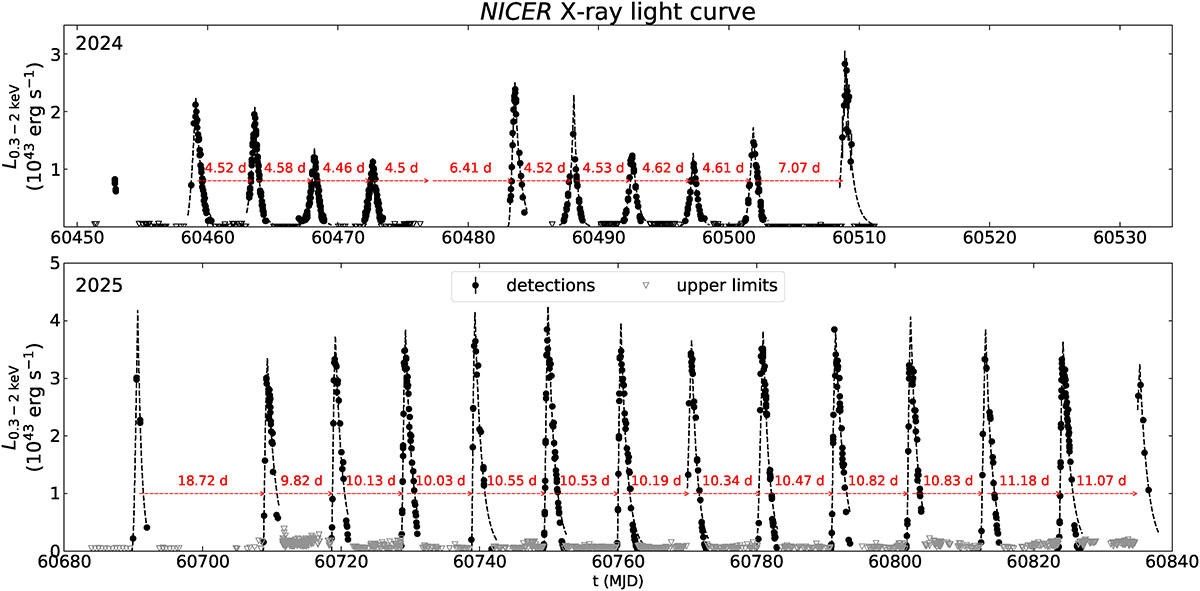
We analyze new NICER observations of QPEs in Ansky. The 2025 QPEs are found to be four times more energetic, with recurrence times of approximately 10 days and flare durations ranging from 2.5 to 4 days, making them both about twice as long as in 2024. We explore different theoretical scenarios, including evolving stream–disk interactions in an extreme mass-ratio inspiral system.
Hernández-García, Sánchez-Sáez, Chakraborty, Cuadra, Miniutti, Arcodia, Arévalo, et al.
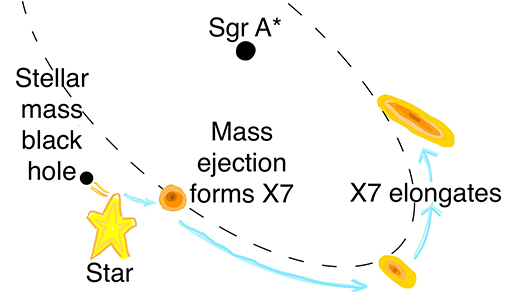
Several enigmatic dusty sources have been detected in the central parsec of the Galactic Center. Among them is X7, that it is becoming elongated due to the tidal forces of Sgr A*. Our results show that a grazing collision between the star S33/S0-30 and a field object such as a stellar mass black hole or a Jupiter-mass object is a viable scenario to explain the origin of X7.
Shaqil, Calderón, Rosswog, Cuadra, Ciurlo, Morris, Campbell, and Ghez
UHH press release: A mysterious cloud near the Milky Way’s black hole is being torn apart
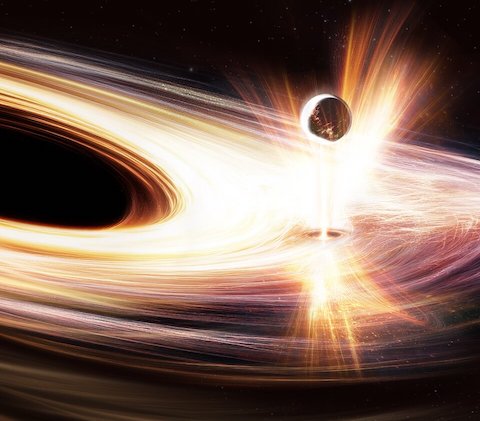
The galaxy SDSS1335+0728 exhibited an increase in optical brightness in December 2019, followed by persistent AGN-like variability for 5 yr, suggesting the activation of a ~1e6-Msun black hole. Since February 2024, X-ray emission has been detected, revealing extreme ~4.5-d QPEs with high fluxes and amplitudes, long timescales, large integrated energies and a ~25-d superperiod.
Hernández-García, Chakraborty, Sánchez-Sáez, Ricci, Cuadra, McKernan, Ford, Arévalo, et al.
ESA Press Release: From boring to bursting: a giant black hole awakens
Artículo en revista RAL: El Despertar De Un Agujero Negro Gigante

We performed simulations of the observed WR stars feeding Sgr A*. We focus on the impact of the chemical composition of the plasma. We conclude that the stellar winds alone are not sufficient to form the cold disc around Sgr A* inferred from observations.
Calderón, Cuadra, Russell, Burkert, Rosswog, and Balakrishnan
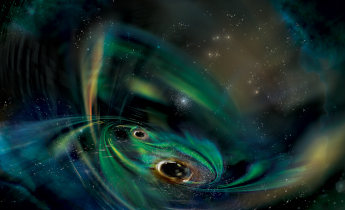
AT 2021hdr started to present sudden brightening episodes in the form of oscillating peaks. We propose that this behavior might be due to the tidal disruption of a gas cloud by a BSMBH. We estimate that the putative binary has a separation of about 0.83 mpc and would merge in about 70000 years.
Hernández-García, Muñoz-Arancibia, Lira, Bruni, Cuadra, Arévalo, Sánchez-Sáez, Bernal, Bauer, Catelan, et al.
NASA Press Release: NASA’s Swift Studies Gas-Churning Monster Black Holes
Nota de la UV: Astrónoma del IFA-UV descubre monstruosos agujeros negros que perturban una nube de gas
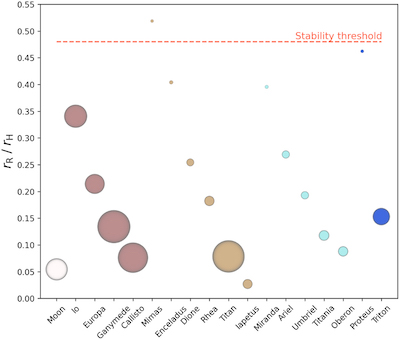
We study the potential formation, stability, and/or decay of hypothetical circumsatellital rings orbiting the largest moons in the Solar System. We attribute their current absence to non-gravitational phenomena
Sucerquia, Alvarado-Montes, Zuluaga, Cuello, Cuadra, and Montesinos
Article on Science Alert: Wait a Minute. Why Don’t Any of The Solar System’s Moons Have Rings?
Nota en el blog de Mario: El Misterio de los Anillos Faltantes en las Lunas del Sistema Solar
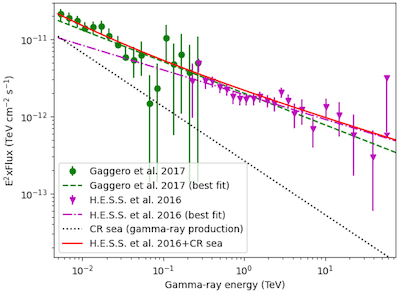
We show that our three previously proposed scenarios for the cosmic ray sources and dynamics in the Galactic centre, which are consistent with the VHE gamma-ray data (1–100 TeV), also match the HE observations (10–300 GeV). Additionally, we analyze the effect of the isotropic Galactic CR “sea” inside the CMZ.
Scherer and Cuadra
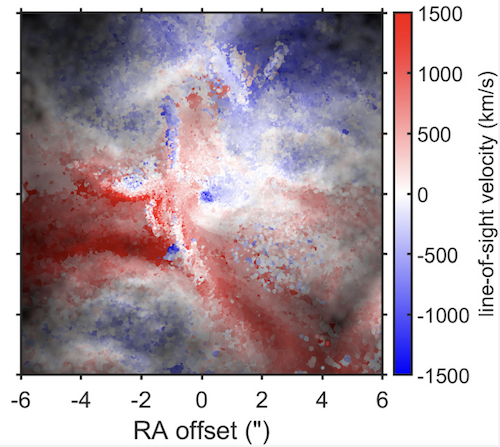
We present updated SPH simulations that find that a cold gas disk forms around Sgr A* . The model presents a good fit to the dispersed Chandra spectra within 1.″5 of Sgr A* . NewAthena will offer a clearer differentiation between a RIAF plasma model and hydrodynamic simulations.
Balakrishnan, Russell, Corrales, Calderón, Cuadra, Haggard, Markoff, Neilsen, Nowak, Wang, and Baganoff
Mayura’s webinar: Dissecting the Sgr A* Accretion Flow in X-rays with Chandra, and Prospects for NewAthena
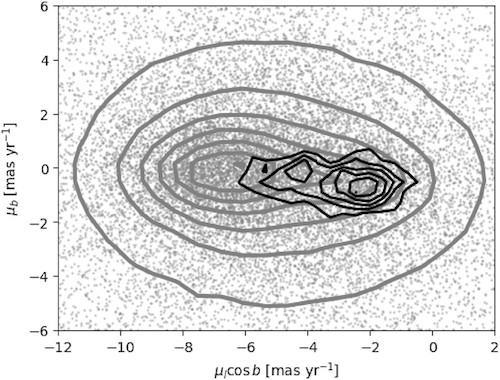
NGC 6357, a star-forming complex at ∼1.7 kpc from the Sun, contains giant molecular clouds and three prominent star clusters alongside H II regions, very massive stars and thousands of young stellar objects in different evolutionary stages. We present a combined infrared kinematic and time domain study of the line of sight towards this region enabled by the VVVX survey.
Ordenes-Huanca, Zoccali, Bayo, Cuadra, Contreras Ramos, and Rojas-Arriagada
Camila’s conference talk: Unveiling the structural content of NGC 6357
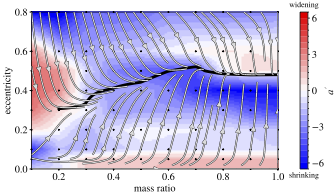
We show that accretion onto the binary depletes the disk mass before inducing a significant change in the orbital separation or the mass ratio. However, the interaction can excite the eccentricity up to an equilibrium value, and induce a statistical correlation between the mass ratio and eccentricity.
Valli, Tiede, Vigna-Gómez, Cuadra, Siwek, Ma, D’Orazio, Zrake, and de Mink
Ruggero’s workshop talk: The Impact of Circumbinary Disks During Stable Mass Transfer
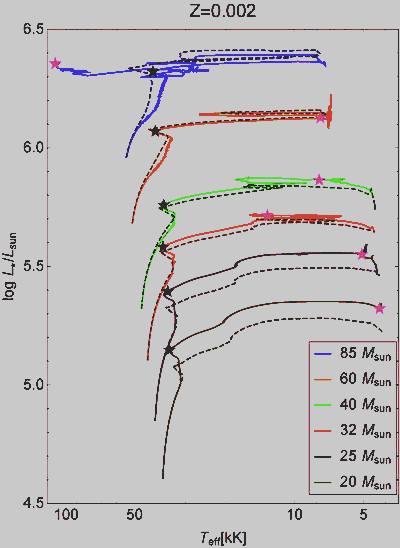
We measure the impact of our mass-loss recipe in the evolution of massive stars at the metallicity of the Small Magellanic Cloud. We find that the stars will lose more mass during their He-core burning stages.
Gormaz-Matamala, Cuadra, Ekström, Meynet, Curé, and Belczynski
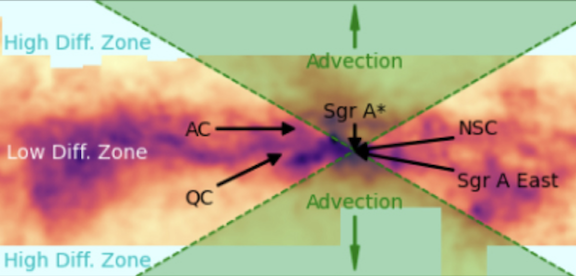
We generated synthetic gamma-ray maps using a CR transport model with spherical injection, different diffusion regimes and polar advection. They show that the CMZ has a large inner cavity and that the GC PeVatron is a composite CR population accelerated by the Arches, Quintuplet, and nuclear star clusters, and Sgr A East.
Scherer, Cuadra, and Bauer
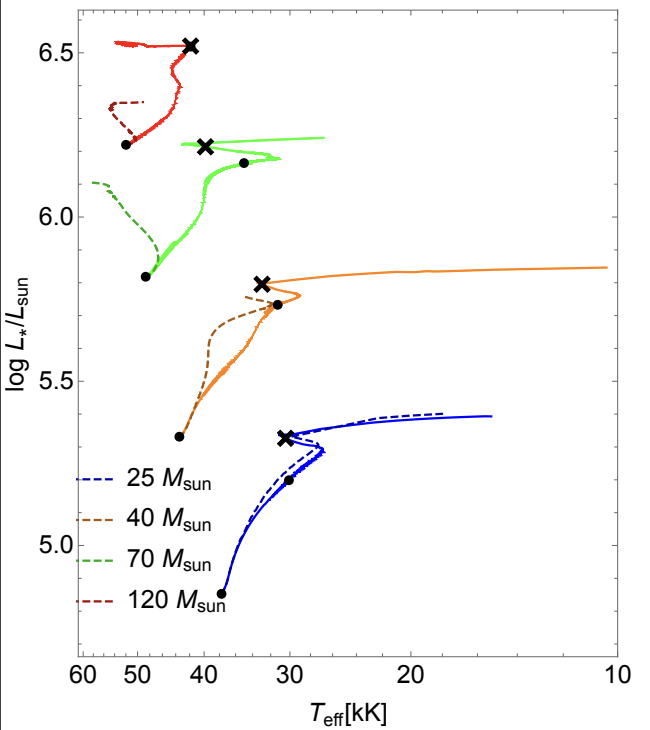
The self-consistent approach gives lower mass-loss rates, which strongly affect the tracks of the most massive models. Weaker winds allow the star to retain more mass, but also more angular momentum. As a consequence, weaker wind models rotate faster and show a less efficient mixing in their inner stellar structure at a given age.
Gormaz-Matamala, Cuadra, Meynet, and Curé

It has been suggested that Thales measured the size of the Sun by timing the sunrise. However, its duration depends on the latitude of the observer and the time of the year. We show that this effect would have prevented Thales from obtaining the correct value.
Cuadra
RAL non-technical article: Tales de Mileto y el tamaño del Sol
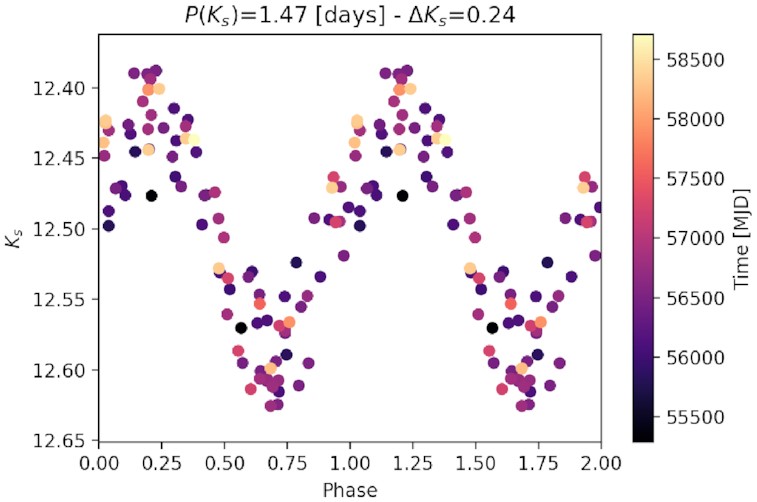
We compile a catalogue of T Tauri light curves to constrain the physical processes responsible for their variation. We find that magnetically active regions remain stable for several years, and that infrared and optical periodicity is in fairly good agreement.
Ordenes-Huanca, Zoccali, Bayo, Cuadra, Contreras Ramos, Hillenbrand, et al.
MAS Press Release: Scientific Paper Includes as co-authors Volunteers in Citizen Science Project
Original version: Publicación científica incluye como co-autores a voluntarios de proyecto de ciencia ciudadana
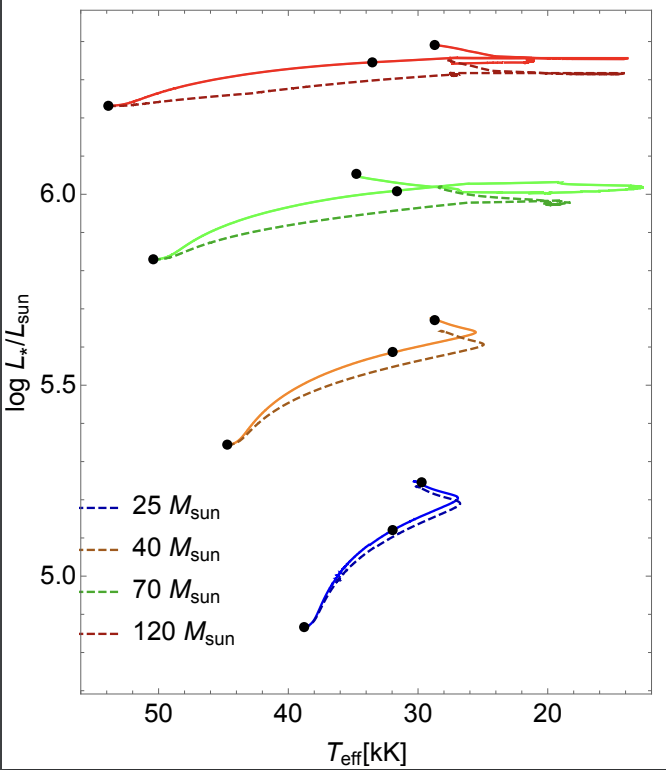
We find important differences between the standard tracks and our new self-consistent tracks. Models adopting the new recipe retain more mass, which is expressed as larger radii and more luminous tracks.
Gormaz-Matamala, Curé, Meynet, Cuadra, Groh, and Murphy
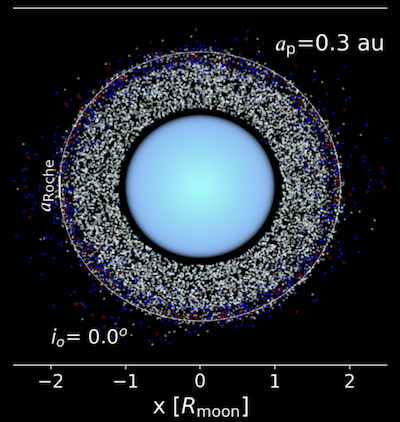
We studied theoretically the formation and dynamical evolution of ring systems around exo-moons, expected to be discovered in transit light-curves. Kepler-1625b I, identified as a Neptune-sized exo-moon, could in fact correspond to a ringed Earth-sized object.
Sucerquia, Alvarado-Montes, Bayo, Cuadra, Cuello, Giuppone, Montesinos, Olofsson, Schwab, Spitler, and Zuluaga
NPF Press Release: Searching for moons with rings outside the Solar System
Original version: Buscando lunas con anillos fuera del Sistema Solar
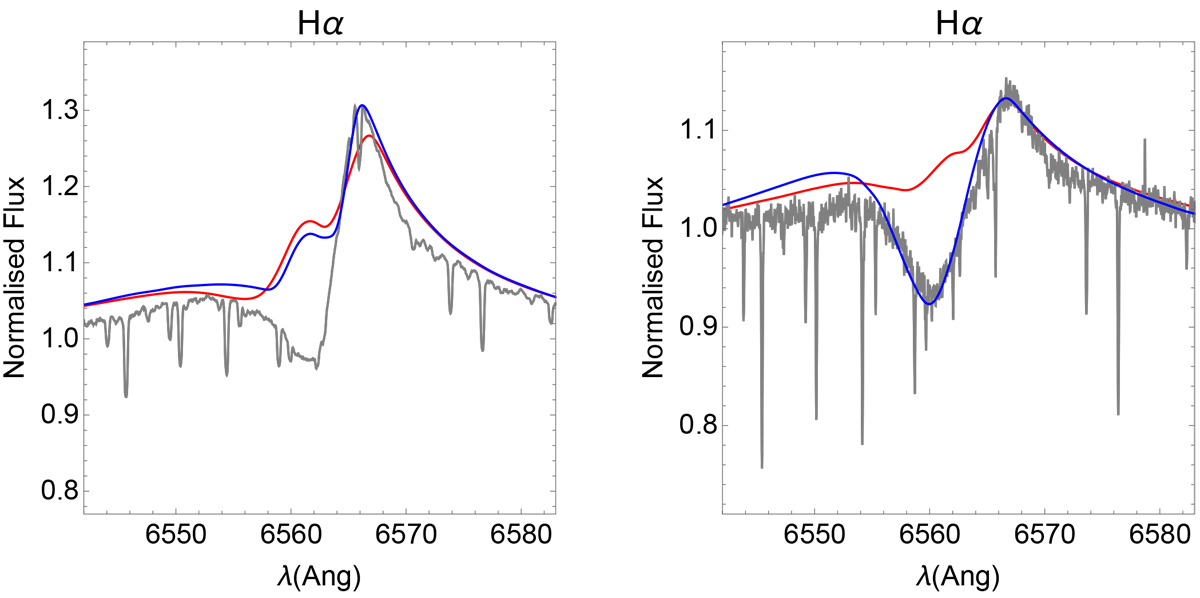
We performed a spectral fitting for a set of O-type stars based on self-consistent wind solutions, which provide mass-loss rate and velocity profiles directly derived from the initial stellar parameters.
Gormaz-Matamala, Curé, Lobel, Panei, Cuadra, Araya, Arcos, and Figueroa-Tapia
Nota de la UAI: Astrónomos UAI: un aporte desde Chile para la comprensión del universo
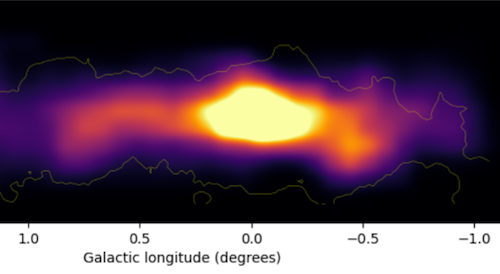
We find that if the Galactic centre hosts only a persistent cosmic ray source, a disk-like gas distribution of gas in the central molecular zone is needed to reproduce the gamma-ray observations. For the expected cavity to be allowed, an additional impulsive cosmic-ray source is needed.
Scherer, Cuadra, and Bauer
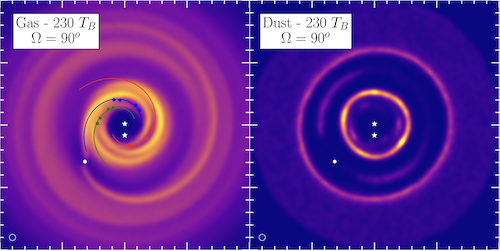
We suggest that the structures in the central region of HD 169142 are produced by an inner stellar binary and a circumbinary planet. Our model reproduces structures at the innermost dust ring and the shape of spiral features in scattered light.
Poblete, Cuello, Pérez, Marino, Calcino, et al. (incl. Cuadra)
NPF Press Release: Researchers propose the existence of a companion star for the HD169142 system
Original version: Investigadores proponen la existencia de una estrella compañera para el sistema HD169142
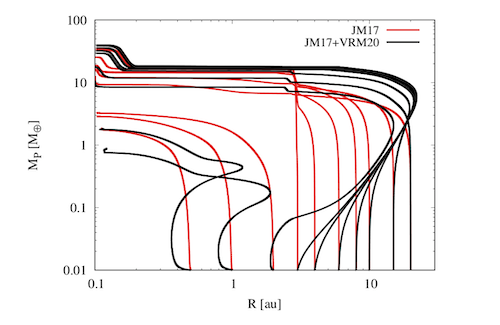
We study the role of the thermal torque within the pebble accretion paradigm. Our simulations show that the thermal torque generates extended regions of outward migration in low-viscosity discs. This has a significant impact in the formation of the planets.
Guilera, Miller Bertolami, Masset, Cuadra, Venturini, and Ronco
Astrobites summary: Planets go weeee!
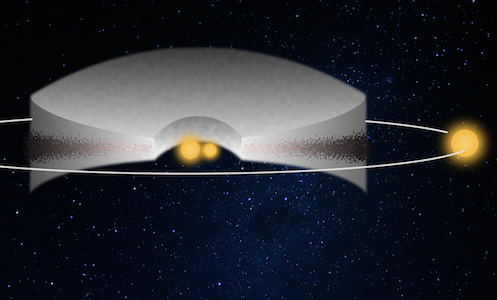
We model the long-term evolution of circumbinary gaseous discs in triple systems, finding their lifetimes to be extended for more than 10 Myr. We apply this model to the disc around HD 98800B.
Ronco, Guilera, Cuadra, Miller Bertolami, Cuello, Fontecilla, Poblete, and Bayo
NPF Press Release: Studying the time evolution of the disks in which planets form
Original version: Estudiando la evolución temporal de los discos en los que se forman los planetas
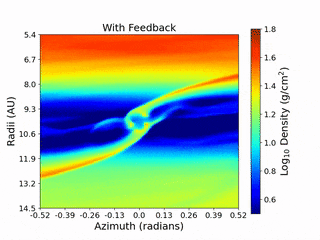
We find that feedback reduces but does not halt the accretion on to the planet. Planet heating gives the accretion rate a stochastic variability, opposite to the periodic variability due to an eccentric orbit.
Gárate, Cuadra, Montesinos, and Arévalo
NPF Press Release: How does a forming planet behave?
Original version: ¿Cómo se comporta un planeta en formación?
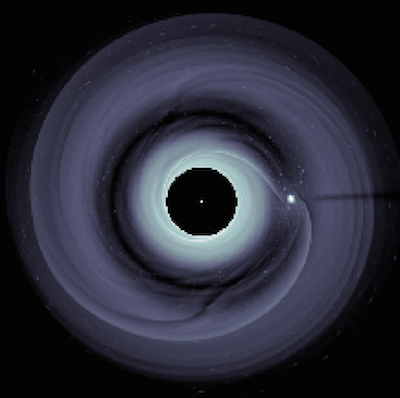
We calculate the effect of an accreting planet on the scale height of the disc, including radiative pressure. We find a large, optically thick column of gas and dust at the protoplanet location, able to cast shadows on the outer disc.
Montesinos, Cuello, Olofsson, Cuadra, Bayo, Bertrang, and Perrot
NPF Press Release: The Shadow Play of Forming Planets
Original version: El juego de sombras de los planetas en formación
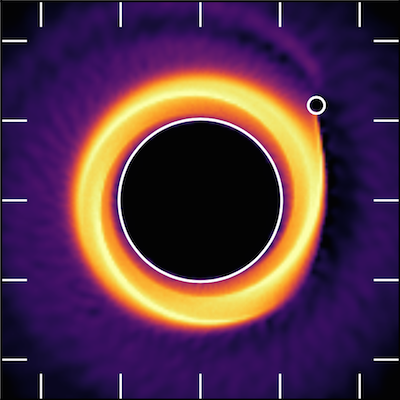
Our main results are that if the gas cannot cool fast enough the disc becomes thick and renders the system invisible, while in the opposite case the strong cooling blocks any leakage on to the secondary’s orbit, allowing an enhancement in the accretion rate.
Fontecilla, Lodato, and Cuadra
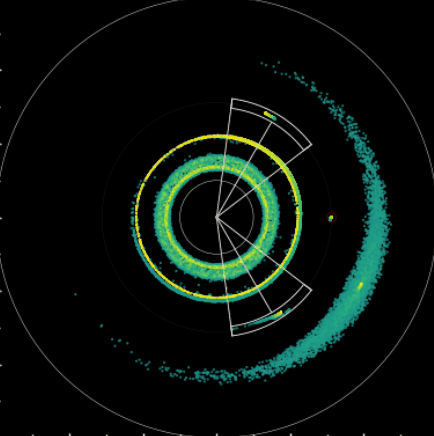
We follow the evolution of a protoplanetary disk with an embedded giant planet. We find that the leading Lagrangian point L4 traps a larger amount of submillimeter particles than the trailing L5, which traps mostly mm-cm particles.
Montesinos, Garrido-Deutelmoser, Olofsson, et al. (incl. Cuadra)
NPF press release: Trojans in our Solar System.
Original version: Los troyanos en nuestro Sistema Solar.
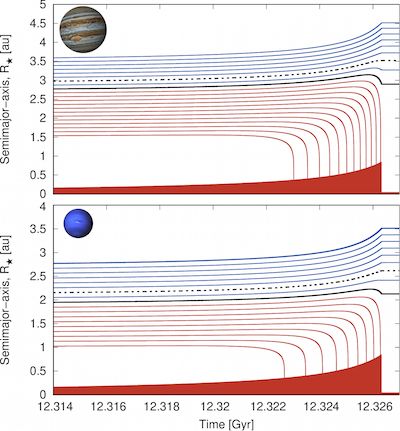
We study the post-main-sequence evolution of planetary systems with an inner Neptune and an outer Jupiter. We find that gravitational interactions between the planets (in particular, resonances) can change whether they survive engulfment by the host star as it turns into a red giant.
Ronco, Schreiber, Giuppone, Veras, Cuadra, and Guilera
AAS Nova article: How Planets Can Save or Destroy Their Siblings
NPF press release: Hero or villain? A Jupiter can save or destroy a Neptune while the host star transforms into a Red Giant.
Original version: ¿Héroe o villano? Un Júpiter puede salvar o destruir a un Neptuno mientras la estrella anfitriona se transforma en Gigante Roja.
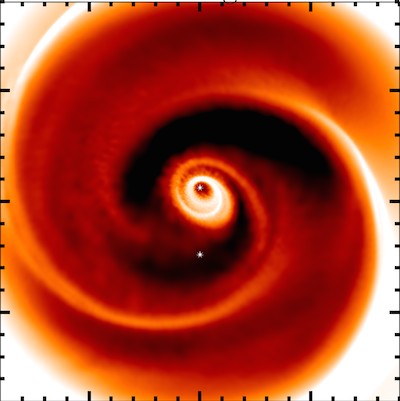
We use numerical simulations to show that the inner spiral structure observed in AB Aurigae can be created by a binary star orbiting inside the dust cavity. We constrain the inclination of the binary with respect to the circumbinary disc to range between 60° and 90°.
Poblete, Calcino, Cuello, Macías, Ribas, Price, Cuadra, and Pinte
Article from Science Alert: Astronomers Are Now Disagreeing Over Those Epic ‘New Planet Birth’ Images
Nota del NPF: Astrónomos ponen en duda que un planeta en formación sea el causante de épica imagen
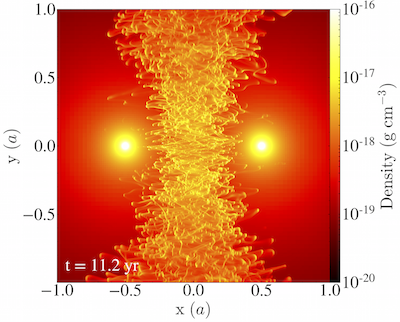
We develop AMR simulations to characterise the clump formation process in unstable wind collisions. Applying the results to the Galactic Centre, we find the clumps do not survive for long enough to fall on to the central supermassive black hole.
Calderón, Cuadra, Schartmann, Burkert, Prieto, and Russell
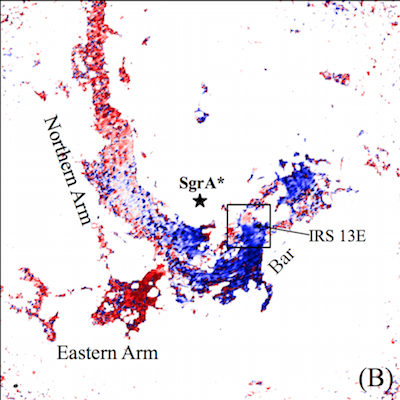
We present a multiwavelength study of the group. The observed emission is not quite well reproduced by simulated colliding winds, so we argue the group is colliding with the mini-spiral. The presence of an IMBH is not necessary to explain the observed stellar and gas properties of IRS 13E.
Wang, Li, Russell, and Cuadra
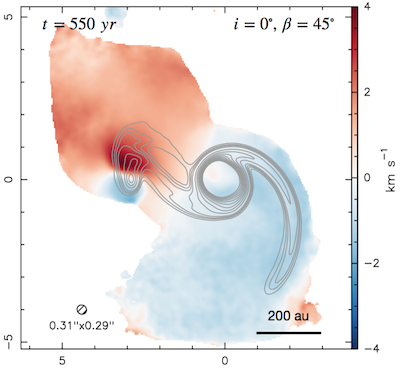
Flybys produce warped discs, spirals with evolving pitch angles, increasing accretion rates, and disc truncation. Here, we present the corresponding observational signatures of these features in optical/near-infrared scattered light and (sub) millimetre continuum and CO line emission.
Cuello, Louvet, Mentiplay, et al. (incl. Cuadra)
Nota del NPF: Escenas de crimen astrofísicas: ¿Cómo se ve un disco protoplanetario luego de un encuentro estelar?
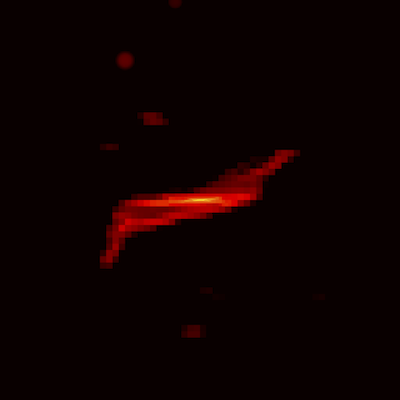
We show that the Wolf-Rayet winds in the Galactic Centre can naturally account for both the hot, inefficient accretion flow, as well as the formation of a cold disk-like structure.
Calderón, Cuadra, Schartmann, Burkert, and Russell
Research highlight feature in Nature Astronomy: Feeding frenzy has faded
Artículo en La Tercera: Astrónomos chilenos prueban que existe un disco de gas en torno al agujero negro en el centro de nuestra galaxia
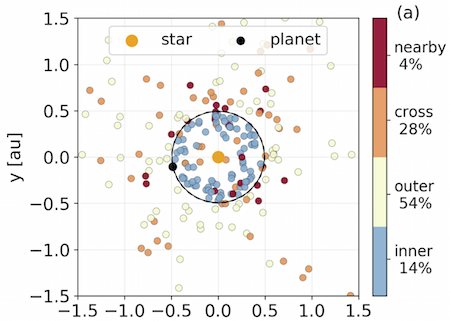
This paper explores the scenario where large regular exomoons escape after tidal interchange of angular momentum with its parent planet, becoming small planets by themselves. We name this hypothetical type of object a ploonet.
Sucerquia, Alvarado-Montes, Zuluaga, Cuello, and Giuppone
Smart Banana cartoon: There Are Not Only Planets In Space, But Ploonets!
Astronomy.com article: Ploonets: When a planet’s moon goes rogue

We study the dust and gas dynamics in circumbinary discs around eccentric and inclined binaries. Two kinds of dust structures can form in the disc: a single horseshoe-shaped clump or numerous clumps along the inner disc rim. These could be used to infer the orbital parameters of a stellar companion.
Poblete, Cuello, and Cuadra
Artículo en La Tercera: Estudio chileno ayudará a identificar sistemas planetarios con dos estrellas
Nota del NPF: ¿Cómo afectan los sistemas estelares dobles a los discos protoplanetarios?
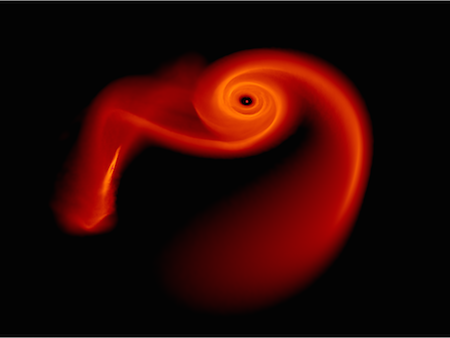
We find that flybys by a stellar perturber induce evolving spiral structure in a protoplanetary disc, which can persist for thousands of years after periastron. The remnant discs are truncated and warped.
Cuello, Dipierro, Mentiplay, et al. (incl. Cuadra and Poblete)
Robo Planetario, augmented reality painting based on this work (article and short video in Spanish)
NPF press release: NPF researchers study stellar encounters.
Original version: Investigadores del NPF estudian encuentros estelares.
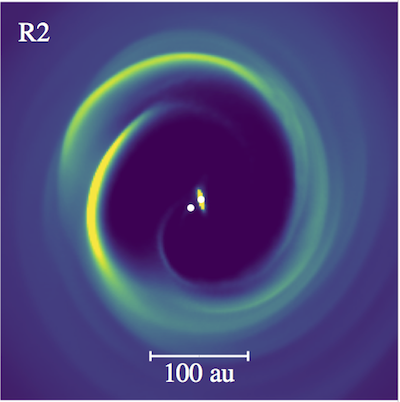
We present simulations of the HD 142527 protoplanetary disc, which shows spirals and shadows around a 100 au gas cavity, a large horseshoe mm-dust structure, together with fast radial flows and streamers. We show that all of these features can be explained by the interaction between the disc and the observed binary companion.
Price, Cuello, Pinte, et al. (incl. Cuadra)
Monash press release: New computer simulations uncover the cause of mystery cosmic ‘horseshoe’ dust
NPF press release: International team of astronomers explains the cause of the mysterious shape of the disk surrounding a young star.
Original version: Equipo internacional de astrónomos explica la causa de la misteriosa forma de disco alrededor de estrella joven.
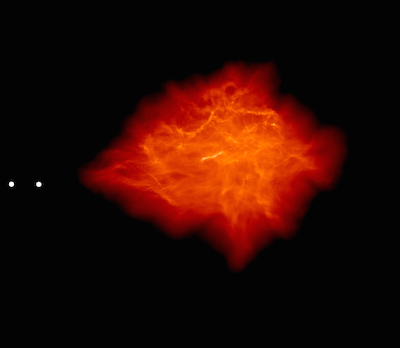
We model the dynamical evolution of a massive black hole binary accreting infalling molecular clouds, finding that is dominated by the exchange of angular momentum through gas capture by the individual black holes and accretion. We show that the binary efficiently evolves down to the gravitational wave regime, overcoming the ‘final parsec’ problem.
Goicovic, Sesana, Cuadra, and Stasyszyn
PUC press release: PhD graduate at the Institute of Astrophysics UC publishes article on the evolution of binary black holes.
Original version: Doctorado del Instituto de Astrofísica publicará artículo sobre la evolución de agujeros negros binarios.
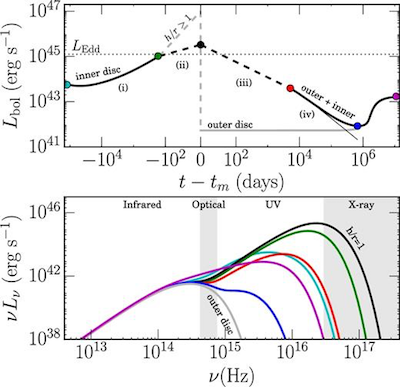
A luminous outburst is expected when a massive black hole binary ‘decouples’ from the circumbinary disc, squeezing the inner disc. Here, we show that the disc within about 20 Rs survives the merger due to a ‘second decoupling’, where the inner disc thickens because of tidal heating, decoupling from the binary.
Fontecilla, Chen, and Cuadra
PUC press release: UC astronomers perform simulation that allows the search for super massive binary black holes.
Original version: Astrónomos UC realizan simulación que permite buscar agujeros negros súper masivos binarios.
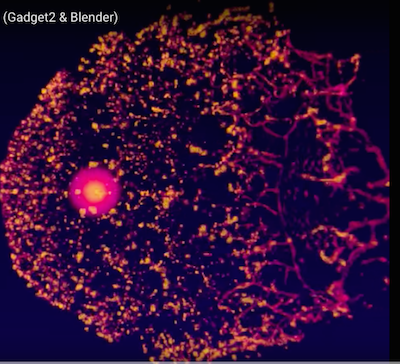
We show how to use the open-source software Blender as a 3D tool to study and visualize numerical simulation results, focusing on astrophysical hydrodynamic experiments. This method allows scientists to perform a complementary visual analysis of their data and display their results in an appealing way.
Gárate
Code available Blender_Bvoxer
PUC press release: UC Master student publishes invited paper on visualization of simulations.
Original version: Alumno del Magíster en Astrofísica publica artículo sobre visualización de simulaciones.
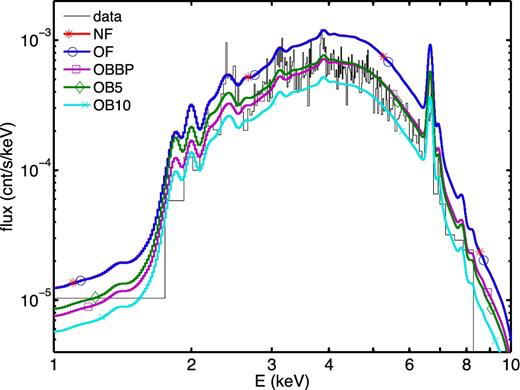
We compare synthetic X-ray images and spectra from simulations of the Galactic Centre with Chandra observations. The models reproduce well the spectral shape, confirming that the hot gas comes from colliding Wolf-Rayet winds. The model in which Sgr A* produced an outflow during the last few centuries best matches the observations.
Russell, Wang, and Cuadra
NASA press release ‘A New Galactic Center Adventure in Virtual Reality’ on our Galactic Center VR app developed from this work.
NASA press release ‘Galactic Center Visualization Delivers Star Power ’ on our 360° video based on this analysis.

We present numerical models of the gas dynamics in Galactic Centre. We follow the gas from its origin as stellar winds, until it is either captured by the central black hole or leaves the region. We include an outflow from the inner accretion flow. We find the outflow to significantly perturb the gas dynamics near the Bondi radius and the black hole capture rate.
Cuadra, Nayakshin, and Wang
360° video from the simulations
NASA press release for the video: Scientists Take Viewers to the Center of the Milky Way
Full List
(since 2015)
109.- NICER observations reveal doubled timescales in Ansky’s quasi-periodic eruptions
Hernández-García, Sánchez-Sáez, Chakraborty, Cuadra, Miniutti, Arcodia, Arévalo, et al.
A&A 703, A263 (2025)
108.- Tidal phenomena in the Galactic Center: The curious case of X7
Shaqil, Calderón, Rosswog, Cuadra, Ciurlo, Morris, Campbell, and Ghez
A&A 700, A134 (2025)
107.- Discovery of extreme quasi-periodic eruptions in a newly accreting massive black hole
Hernández-García, Chakraborty, Sánchez-Sáez, Ricci, Cuadra, McKernan, Ford, Arévalo, et al.
NatAs 9, 895 (2025)
106.- Ionized Envelopes Around Protoplanets and the Role of Radiative Feedback in Gas Accretion
Montesinos, Garrido-Deutelmoser, Cuadra, Sucerquia, Cuello, Schreiber, Ronco, and Guilera
ApJ 985, 36 (2025)
105.- Combining REBOUND and MESA: dynamical evolution of planets orbiting interacting binaries
Xing, Torres, Götberg, Trani, Korol, and Cuadra
MNRAS 537, 285 (2025)
104.- The role of shocks and the velocity gradient in the relative orientation of the magnetic field and dense gas clouds
Granda-Muñoz, Vázquez-Semadeni, and Gómez
A&A 694, A296 (2025)
103.- The formation and stability of a cold disc made out of stellar winds in the Galactic centre
Calderón, Cuadra, Russell, Burkert, Rosswog, and Balakrishnan
A&A 693, A180 (2025)
102.- AT 2021hdr: A candidate tidal disruption of a gas cloud by a binary super massive black hole system
Hernández-García, Muñoz-Arancibia, Lira, Bruni, Cuadra, Arévalo, Sánchez-Sáez, Bernal, Bauer, Catelan, et al.
A&A 692, A84 (2024)
101.- The missing rings around Solar System moons
Sucerquia, Alvarado-Montes, Zuluaga, Cuello, Cuadra, and Montesinos
A&A 691, A74 (2024)
100.- Multiwavelength Galactic center gamma-ray observations explained by a unified cosmic-ray dynamics model
Scherer and Cuadra
A&A 690, L14 (2024)
99.- Multistructured Accretion Flow of Sgr A*. II. Signatures of a Cool Accretion Disk in Hydrodynamic Simulations of Stellar Winds
Balakrishnan, Russell, Corrales, Calderón, Cuadra, Haggard, Markoff, Neilsen, Nowak, Wang, and Baganoff
ApJ 974, 99 (2024)
98.- Multistructured Accretion Flow of Sgr A*. I. Examination of a Radiatively Inefficient Accretion Flow Model
Balakrishnan, Corrales, Markoff, Nowak, Haggard, Wang, Neilsen, Russell, Calderón, Cuadra, and Baganoff
ApJ 974, 98 (2024)
97.- Prospects for γ-ray observations of the Perseus galaxy cluster with the Cherenkov Telescope Array
Abe, Abe, Acero, et al. (incl. Scherer)
JCAP 2024, 004 (2024)
96.- Unveiling the structural content of NGC 6357 via kinematics and NIR variability
Ordenes-Huanca, Zoccali, Bayo, Cuadra, Contreras Ramos, and Rojas-Arriagada
MNRAS 533, 841 (2024)
95.- Long-term evolution of binary orbits induced by circumbinary disks
Valli, Tiede, Vigna-Gómez, Cuadra, Siwek, Ma, D’Orazio, Zrake, and de Mink
A&A 688, A128 (2024)
94.- Dark matter line searches with the Cherenkov Telescope Array
Abe, Abhir, Abhishek, et al. (incl. Scherer)
JCAP 2024, 047 (2024)
93.- Evolution of rotating massive stars adopting a newer, self-consistent wind prescription at Small Magellanic Cloud metallicity
Gormaz-Matamala, Cuadra, Ekström, Meynet, Curé, and Belczynski
A&A 687, A290 (2024)
92.- Alpha Centauri: Disc Dynamics, Planet Stability, Detectability
Cuello and Sucerquia
Univ 10, 64 (2024)
91.- The wind of rotating B supergiants - II. The δ-slow hydrodynamic regime
Venero, Curé, Puls, Cidale, Haucke, Araya, Gormaz-Matamala, and Arcos
MNRAS 527, 93 (2024)
90.- Modeling the Galactic center gamma-ray emission with more realistic cosmic-ray dynamics
Scherer, Cuadra, and Bauer
A&A 679, A114 (2023)
89.- Sensitivity of the Cherenkov Telescope Array to TeV photon emission from the Large Magellanic Cloud
Acharyya, Adam, Aguasca-Cabot, et al. (incl. Scherer)
MNRAS 523, 5353 (2023)
88.- Resolving the binary components of the outbursting protostar HBC 494 with ALMA
Nogueira, Zurlo, Pérez, et al. (incl. Cuadra)
MNRAS 523, 4970 (2023)
87.- Sensitivity of the Cherenkov Telescope Array to spectral signatures of hadronic PeVatrons with application to Galactic Supernova Remnants
Acero, Acharyya, Adam, et al. (incl. Scherer)
APh 150, 102850 (2023)
86.- Evolution of rotating massive stars with new hydrodynamic wind models
Gormaz-Matamala, Cuadra, Meynet, and Curé
A&A 673, A109 (2023)
85.- Astrophysics with the Laser Interferometer Space Antenna
Amaro-Seoane, Andrews, Arca Sedda, et al. (incl. Cuadra)
LRR 26, 2 (2023)
84.- The asymmetric sunrise effect on Thales’ alleged measurement of the Sun angular size
Cuadra
PASJ 75, L12 (2023)
83.- Infrared variability of young solar analogues in the Lagoon Nebula
Ordenes-Huanca, Zoccali, Bayo, Cuadra, Contreras Ramos, Hillenbrand, et al.
MNRAS 517, 6191 (2022)
82.- Evolution of massive stars with new hydrodynamic wind models
Gormaz-Matamala, Curé, Meynet, Cuadra, Groh, and Murphy
A&A 665, A133 (2022)
81.- Cronomoons: origin, dynamics, and light-curve features of ringed exomoons
Sucerquia, Alvarado-Montes, Bayo, Cuadra, Cuello, Giuppone, Montesinos, Olofsson, Schwab, Spitler, and Zuluaga
MNRAS 512, 1032 (2022)
80.- New self-consistent wind parameters to fit optical spectra of O-type stars observed with the HERMES spectrograph
Gormaz-Matamala, Curé, Lobel, Panei, Cuadra, Araya, Arcos, and Figueroa-Tapia
A&A 661, A51 (2022)
79.- Galactic center gamma-ray production by cosmic rays from stellar winds and Sgr A East
Scherer, Cuadra, and Bauer
A&A 659, A105 (2022)
78.- The protoplanetary disc around HD 169142: circumstellar or circumbinary?
Poblete, Cuello, Pérez, Marino, Calcino, et al. (incl. Cuadra)
MNRAS 510, 205 (2022)
77.- The importance of thermal torques on the migration of planets growing by pebble accretion
Guilera, Miller Bertolami, Masset, Cuadra, Venturini, and Ronco
MNRAS 507, 3638 (2021)
76.- The HD 98800 quadruple pre-main sequence system. Towards full orbital characterisation using long-baseline infrared interferometry
Zúñiga-Fernández, Olofsson, Bayo, Haubois, Corral-Santana, Lopera-Mejía, Ronco, Tokovinin, Gallenne, Kennedy, and Berger
A&A 655, A15 (2021)
75.- New Hydrodynamic Solutions for Line-driven Winds of Hot Massive Stars Using the Lambert W-function
Gormaz-Matamala, Curé, Hillier, Najarro, Kubátová, and Kubát
ApJ 920, 64 (2021)
74.- Long Live the Disk: Lifetimes of Protoplanetary Disks in Hierarchical Triple-star Systems and a Possible Explanation for HD 98800 B
Ronco, Guilera, Cuadra, Miller Bertolami, Cuello, Fontecilla, Poblete, and Bayo
ApJ 916, 113 (2021)
73.- Analytical solutions for radiation-driven winds in massive stars - II. The δ-slow regime
Araya, Christen, Curé, Cidale, Venero, Arcos, Gormaz-Matamala, Haucke, Escárate, and Clavería
MNRAS 504, 2550 (2021)
72.- A Detailed Characterization of HR 8799’s Debris Disk with ALMA in Band 7
Faramaz, Marino, Booth, Matrà, Mamajek, Bryden, Stapelfeldt, Casassus, Cuadra, Hales, and Zurlo
AJ 161, 271 (2021)
71.- Feedback-limited Accretion: Variable Luminosity from Growing Planets
Gárate, Cuadra, Montesinos, and Arévalo
MNRAS 501, 3113 (2021)
70.- Radiative Scale Height and Shadows in Protoplanetary Disks
Montesinos, Cuello, Olofsson, Cuadra, Bayo, Bertrang, and Perrot
ApJ 910, 31 (2021)
69.- WD 1856 b: a close giant planet around a white dwarf that could have survived a common envelope phase
Lagos, Schreiber, Zorotovic, Gänsicke, Ronco, and Hamers
MNRAS 501, 676 (2021)
68.- Hybrid stars with sequential phase transitions: the emergence of the g2 mode
Rodríguez, Ranea-Sandoval, Mariani, Orsaria, Malfatti, and Guilera
JCAP 2021, 009 (2021)
67.- Discontinuity g modes of hybrid stars: Effect of sequential phase transitions
Rodríguez, Ranea-Sandoval, Mariani, Malfatti, and Guilera
AN 342, 305 (2021)
66.- The effect of cooling on the accretion of circumprimary discs in merging supermassive black hole binaries
Fontecilla, Lodato, and Cuadra
MNRAS 499, 2836 (2020)
65.- Most super-Earths formed by dry pebble accretion are less massive than 5 Earth masses
Venturini, Guilera, Ronco, and Mordasini
A&A 644, A174 (2020)
64.- The nature of the radius valley. Hints from formation and evolution models
Venturini, Guilera, Haldemann, Ronco, and Mordasini
A&A 643, L1 (2020)
63.- Dust trapping around Lagrangian points in protoplanetary disks
Montesinos, Garrido-Deutelmoser, Olofsson, et al. (incl. Cuadra)
A&A 642, A224 (2020)
62.- Giant planet formation at the pressure maxima of protoplanetary disks. II. A hybrid accretion scenario
Guilera, Sándor, Ronco, Venturini, and Miller Bertolami
A&A 642, A140 (2020)
61.- Setting the Stage: Planet Formation and Volatile Delivery
Venturini, Ronco, and Guilera
SSRv 216, 86 (2020)
60.- How Jupiters save or destroy inner Neptunes around evolved stars
Ronco, Schreiber, Giuppone, Veras, Cuadra, and Guilera
ApJL 898, L23 (2020)
59.- Ongoing flyby in the young multiple system UX Tauri
Ménard, Cuello, Ginski, et al.
A&A 639, L1 (2020)
58.- Binary-induced spiral arms inside the disc cavity of AB Aurigae
Poblete, Calcino, Cuello, Macías, Ribas, Price, Cuadra, and Pinte
MNRAS 496, 2362 (2020)
57.- The VISTA Variables in the Vía Láctea infrared variability catalogue (VIVA-I)
Ferreira Lopes, Cross, Catelan, et al. (incl. Russell)
MNRAS 496, 1730 (2020)
56.- Three-dimensional simulations of clump formation in stellar wind collisions
Calderón, Cuadra, Schartmann, Burkert, Prieto, and Russell
MNRAS 493, 447 (2020)
55.- Colliding winds in and around the stellar group IRS 13E at the galactic centre
Wang, Li, Russell, and Cuadra
MNRAS 492, 2481 (2020)
54.- Flyby-induced misalignments in planet-hosting discs
Nealon, Cuello, and Alexander
MNRAS 491, 4108 (2020)
53.- Flybys in protoplanetary discs - II. Observational signatures
Cuello, Louvet, Mentiplay, et al. (incl. Cuadra)
MNRAS 491, 504 (2020)
52.- Resolving the FU Orionis System with ALMA: Interacting Twin Disks?
Pérez, Hales, Liu, et al. (incl. Cuello)
ApJ 889, 59 (2020)
51.- Stellar Winds Pump the Heart of the Milky Way
Calderón, Cuadra, Schartmann, Burkert, and Russell
ApJL 888, L2 (2020)
50.- Signatures of an eccentric disc cavity: Dust and gas in IRS 48
Calcino, Price, Pinte, et al. (incl. Cuello)
MNRAS 490, 2579 (2019)
49.- Ploonets: formation, evolution, and detectability of tidally detached exomoons
Sucerquia, Alvarado-Montes, Zuluaga, Cuello, and Giuppone
MNRAS 489, 2313 (2019)
48.- Dusty clumps in circumbinary discs
Poblete, Cuello, and Cuadra
MNRAS 489, 2204 (2019)
47.- From Scattered-light to Millimeter Emission: A Comprehensive View of the Gigayear-old System of HD 202628 and its Eccentric Debris Ring
Faramaz, Krist, Stapelfeldt, et al. (incl. Cuadra)
AJ 158, 162 (2019)
46.- Planet formation and stability in polar circumbinary discs
Cuello and Giuppone
A&A 628, A119 (2019)
45.- Thermal torque effects on the migration of growing low-mass planets
Guilera, Cuello, Montesinos, Miller Bertolami, Ronco, Cuadra, and Masset
MNRAS 486, 5690 (2019)
44.- Planetesimal fragmentation and giant planet formation. II. Dependencies with planetesimal relative velocities and compositions
San Sebastián, Guilera, and Parisi
A&A 625, A138 (2019)
43.- Flybys in protoplanetary discs: I. Gas and dust dynamics
Cuello, Dipierro, Mentiplay, et al. (incl. Cuadra and Poblete)
MNRAS 483, 4114 (2019)
42.- Non-steady-state long-term evolution of supermassive black hole binaries surrounded by accretion discs
Fontecilla, Haiman, and Cuadra
MNRAS 482, 4383 (2019)
41.- Dusty spirals triggered by shadows in transition discs
Cuello, Montesinos, Stammler, Louvet, and Cuadra
A&A 622, A43 (2019)
40.- Is there really a debris disc around ζ2 Reticuli?
Faramaz, Bryden, Stapelfeldt, et al. (incl. Cuadra)
MNRAS 481, 44 (2018)
39.- Formation of Solar system analogues - II. Post-gas-phase growth and water accretion in extended discs via N-body simulations
Ronco and de Elía
MNRAS 479, 5362 (2018)
38.- Accretion of clumpy cold gas onto massive black hole binaries: a possible fast route to binary coalescence
Goicovic, Maureira-Fredes, Sesana, Amaro-Seoane, and Cuadra
MNRAS 479, 3438 (2018)
37.- The Galactic Centre source G2 was unlikely born in any of the known massive binaries
Calderón, Cuadra, Schartmann, Burkert, Plewa, Eisenhauer, and Habibi
MNRAS 478, 3494 (2018)
36.- OJ287: deciphering the `Rosetta stone of blazars’
Britzen, Fendt, Witzel, et al. (incl. Cuadra)
MNRAS 478, 3199 (2018)
35.- Accretion of clumpy cold gas on to massive black hole binaries: the challenging formation of extended circumbinary structures
Maureira-Fredes, Goicovic, Amaro-Seoane, and Sesana
MNRAS 478, 1726 (2018)
34.- Non-thermal X-rays from colliding wind shock acceleration in the massive binary Eta Carinae
Hamaguchi, Corcoran, Pittard, et al. (incl. Russell)
NatAs 2, 731 (2018)
33.- Circumbinary, not transitional: on the spiral arms, cavity, shadows, fast radial flows, streamers, and horseshoe in the HD 142527 disc
Price, Cuello, Pinte, et al. (incl. Cuadra)
MNRAS 477, 1270 (2018)
32.- Planetary-like spirals caused by moving shadows in transition discs
Montesinos and Cuello
MNRAS 475, L35 (2018)
31.- HD 169142 in the eyes of ZIMPOL/SPHERE
Bertrang, Avenhaus, Casassus, Montesinos, Kirchschlager, Perez, Cieza, and Wolf
MNRAS 474, 5105 (2018)
30.- Proper motions in the VVV Survey: Results for more than 15 million stars across NGC 6544
Contreras Ramos, Zoccali, Rojas, et al. (incl. Gárate)
A&A 608, A140 (2017)
29.- Infalling clouds on to supermassive black hole binaries - II. Binary evolution and the final parsec problem
Goicovic, Sesana, Cuadra, and Stasyszyn
MNRAS 472, 514 (2017)
28.- Size and density sorting of dust grains in SPH simulations of protoplanetary discs
Pignatale, Gonzalez, Cuello, Bourdon, and Fitoussi
MNRAS 469, 237 (2017)
27.- A second decoupling between merging binary black holes and the inner disc - impact on the electromagnetic counterpart
Fontecilla, Chen, and Cuadra
MNRAS 468, L50 (2017)
26.- Voxel Datacubes for 3D Visualization in Blender
Gárate
PASP 129, 058010 (2017)
25.- Satellite infall and mass deposition on the Galactic Centre
Gallego and Cuadra
MNRAS 467, L41 (2017)
24.- Redistribution of CO at the location of the CO ice line in evolving gas and dust disks
Stammler, Birnstiel, Panić, Dullemond, and Dominik
A&A 600, A140 (2017)
23.- Three Radial Gaps in the Disk of TW Hydrae Imaged with SPHERE
van Boekel, Henning, Menu, et al. (incl. Lobo Gomes)
ApJ 837, 132 (2017)
22.- Inner mean-motion resonances with eccentric planets: a possible origin for exozodiacal dust clouds
Faramaz, Ertel, Booth, Cuadra, and Simmonds
MNRAS 465, 2352 (2017)
21.- Modelling the thermal X-ray emission around the Galactic Centre from colliding Wolf-Rayet winds
Russell, Wang, and Cuadra
MNRAS 464, 4958 (2017)
20.- The TDE ASASSN-14li and Its Host Resolved at Parsec Scales with the EVN
Romero-Cañizales, Prieto, Chen, Kochanek, Dong, Holoien, Stanek, and Liu
ApJL 832, L10 (2016)
19.- 94 Ceti: a triple star with a planet and dust disc
Wiegert, Faramaz, and Cruz-Saenz de Miera
MNRAS 462, 1735 (2016)
18.- Searching for molecular outflows in hyperluminous infrared galaxies
Calderón, Bauer, Veilleux, Graciá-Carpio, Sturm, Lira, Schulze, and Kim
MNRAS 460, 3052 (2016)
17.- SDSS J0159+0105: A Radio-Quiet Quasar with a Centi-Parsec Supermassive Black Hole Binary Candidate
Zheng, Butler, Shen, Jiang, Wang, Chen, and Cuadra
ApJ 827, 56 (2016)
16.- Resolving the planetesimal belt of HR 8799 with ALMA
Booth, Jordán, Casassus, Hales, Dent, Faramaz, Matrà, Barkats, Brahm, and Cuadra
MNRAS 460, L10 (2016)
15.- Probing dark matter crests with white dwarfs and IMBHs
Amaro-Seoane, Casanellas, Schödel, Davidson, and Cuadra
MNRAS 459, 695 (2016)
14.- The γ-ray afterglows of tidal disruption events
Chen, Gómez-Vargas, and Guillochon
MNRAS 458, 3314 (2016)
13.- Relativistic mergers of black hole binaries have large, similar masses, low spins and are circular
Amaro-Seoane and Chen
MNRAS 458, 3075 (2016)
12.- Spiral Waves Triggered by Shadows in Transition Disks
Montesinos, Perez, Casassus, Marino, Cuadra, and Christiaens
ApJL 823, L8 (2016)
11.- Unbound Debris Streams and Remnants Resulting from the Tidal Disruptions of Stars by Supermassive Black Holes
Guillochon, McCourt, Chen, Johnson, and Berger
ApJ 822, 48 (2016)
10.- Stability of Gas Clouds in Galactic Nuclei: An Extended Virial Theorem
Chen, Amaro-Seoane, and Cuadra
ApJ 819, 138 (2016)
9.- Clump formation through colliding stellar winds in the Galactic Centre
Calderón, Ballone, Cuadra, Schartmann, Burkert, and Gillessen
MNRAS 455, 4388 (2016)
8.- Infalling clouds on to supermassive black hole binaries - I. Formation of discs, accretion and gas dynamics
Goicovic, Cuadra, Sesana, Stasyszyn, Amaro-Seoane, and Tanaka
MNRAS 455, 1989 (2016)
7.- Accretion Kinematics through the Warped Transition Disk in HD142527 from Resolved CO(6-5) Observations
Casassus, Marino, Pérez, et al. (incl. Dunhill and Cuadra)
ApJ 811, 92 (2015)
6.- Planet Formation Signposts: Observability of Circumplanetary Disks via Gas Kinematics
Perez, Dunhill, Casassus, Roman, Szulágyi, Flores, Marino, and Montesinos
ApJL 811, L5 (2015)
5.- Supermassive Black Holes in a Star-forming Gaseous Circumnuclear Disk
del Valle, Escala, Maureira-Fredes, Molina, Cuadra, and Amaro-Seoane
ApJ 811, 59 (2015)
4.- The role of feedback in accretion on low-luminosity AGN: Sgr A* case study
Cuadra, Nayakshin, and Wang
MNRAS 450, 277 (2015)
3.- Protoplanetary Disks Including Radiative Feedback from Accreting Planets
Montesinos, Cuadra, Perez, Baruteau, and Casassus
ApJ 806, 253 (2015)
2.- Precession and accretion in circumbinary discs: the case of HD 104237
Dunhill, Cuadra, and Dougados
MNRAS 448, 3545 (2015)
1.- 1D accretion discs around eccentric planets: observable near-infrared variability.
Dunhill
MNRAS 448, L67 (2015)